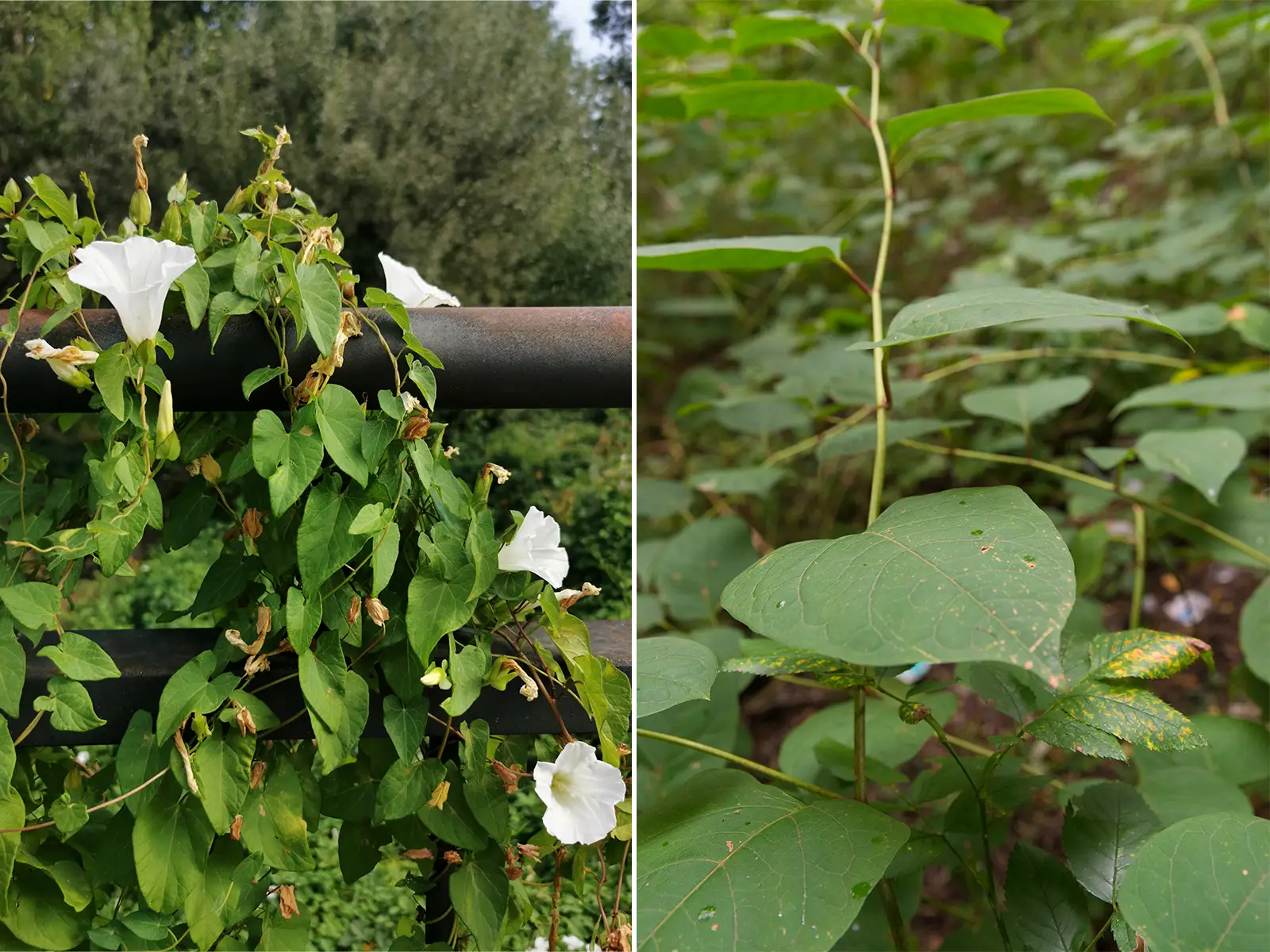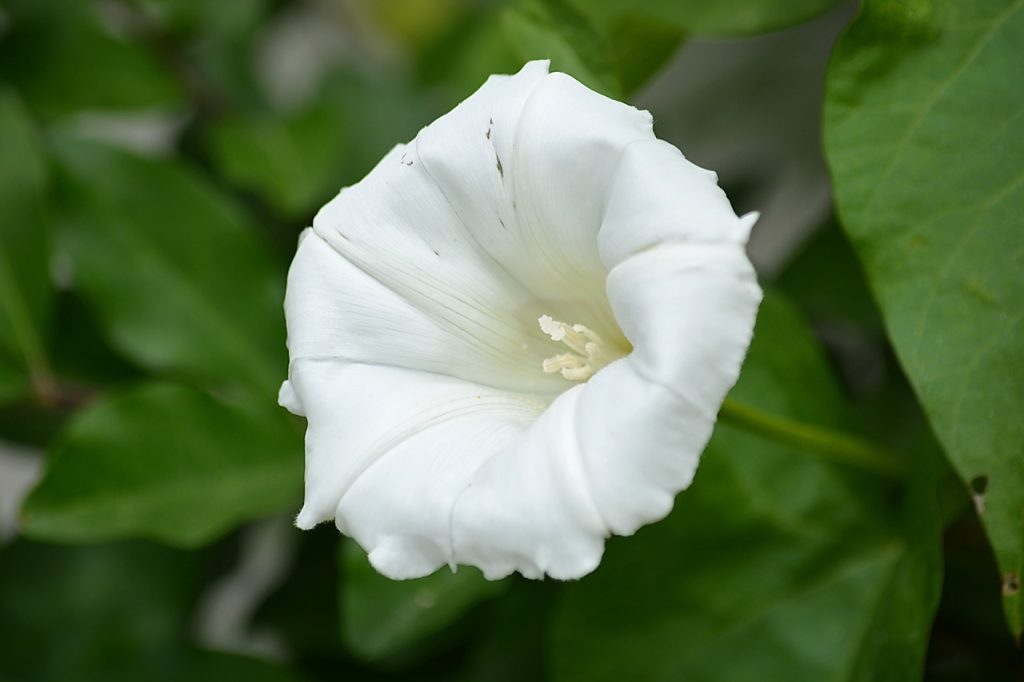Mistaking harmless plants for invasive species or worse, thinking Japanese knotweed is just a common garden weed can have serious consequences for property owners across the UK. The confusion between bindweed and Japanese knotweed is rife and the implications of this misidentification can be costly and legal. Japanese knotweed is notorious for its ability to spread quickly across Britain so accurate identification is more important than ever.
Unlike climbing bindweed, Japanese knotweed is a standalone plant that doesn’t need support.
This guide will provide clear and definitive information on how to tell the difference between these two confused plants. With property values, mortgage applications and legal obligations at stake, accurate identification is not just a botanical interest but a property management skill.
At Knotweed Services we see property owners who have mistaken bindweed for Japanese knotweed or overlooked actual knotweed infestations. This guide is based on our many years of experience helping property owners in these situations.

Invasive Plants
Invasive plants like Japanese knotweed are non native species that can cause harm to the environment, economy and human health. They can outcompete native plants and reduce biodiversity and alter ecosystems. Japanese knotweed is a very invasive plant that can grow up to 3 meters tall and spread rapidly through its root and stem system. It can damage infrastructure like buildings and roads so it’s a big problem for property owners. Knowing the characteristics of invasive plants especially Japanese knotweed is key to preventing their spread and mitigating their impact on both natural and built environments.
Japanese Knotweed: The Invader
Japanese knotweed (Fallopia japonica) was introduced to the UK in the 1840s as an ornamental plant. What the Victorians didn’t know was that this pretty addition would become one of the UK’s most unwanted invasive species.
Giant Knotweed, a less common but just as nasty variety, can grow up to 5 metres tall.
The legal implications of having Japanese knotweed on your property are serious. Under the Wildlife and Countryside Act 1981 it is an offence to plant or cause Japanese knotweed to grow in the wild. As a property owner you have a duty to prevent its spread and failure to control it can result in enforcement action, including prosecution.
Key Features of Japanese Knotweed:
- Growth habit: Upright growth to 2-3m tall
- Stems: Hollow stems with purple speckles, like asparagus spears when new
- Leaves: Large heart-shaped leaves (up to 14cm long) in a zigzag pattern along the stem
- Flowers: Cream white flowers in late summer (August-September)
- Winter: Dead brown stems remain standing
- Roots: Extensive rhizome network up to 7m wide and 3m deep
- Other: Hollow stems with purple speckles are the key identifier.
- Related: Himalayan Knotweed is another member of the knotweed family.
The plant changes a lot with the seasons. In spring red/purple shoots emerge from the ground, develop into hollow stems with raised nodes (giving the bamboo like appearance). By summer the plant is fully leafed and dense with foliage, then produces flowers in late summer. The green leaves at this time make the plant more visible. In autumn the leaves start to yellow and die back, leaving the brown canes that often remain standing through winter.
To identify Japanese knotweed look for the creamy white flowers and bamboo like stems. Unlike plants with woody stems like Lilac and Dogwood Japanese knotweed has hollow stems. It can also be confused with other common plants like Dogwood and Lilac. The rhizome system – an underground network of root like stems – is perhaps the most problematic aspect of Japanese knotweed. These can penetrate foundations, damage buildings and are very hard to get rid of.

Field and Hedge Bindweed: The Common Knotweed Lookalike
Bindweed, which includes Field bindweed (Convolvulus arvensis) and Hedge bindweed (Calystegia sepium) is a group of common climbing plants found in British gardens and wild spaces. Although native to Europe these plants have naturalised across the UK.
Bindweed has thin wiry stems, Japanese knotweed has tall stems up to 3 meters. Japanese knotweed shoots are bamboo like with an initial pink or red colour that later turns green and speckled.
Key Features of Bindweed:
- Growth habit: Climbs/twines around support
- Stems: Thin, wiry, twisting stems up to several metres long but still slender
- Leaves: Arrow or heart-shaped leaves, smaller (2-5cm) than Japanese knotweed leaves, with lobes on either side of the stem, unlike Japanese knotweed
- Flowers: Trumpet-shaped white or pink flowers, like small morning glories, start to bloom in late spring
- Seasonal behaviour: Dies back completely in winter
- Root system: Deep roots but no rhizome
Bindweed has a climbing habit, spirals around garden plants, fences or other support. Leaves are dark green which helps with identification. While persistent and a nuisance for gardeners, its growth habit is different from the self-supporting bamboo-like stems of Japanese knotweed.
Bindweed can be invasive in gardens and hard to get rid of because of its deep roots but it doesn’t pose the same structural threat to buildings and infrastructure as Japanese knotweed nor the same legal implications.

Bindweed vs Japanese Knotweed: Critical Differences
The distinction between these plants becomes clearer when examining their key characteristics side by side:
| Feature | Japanese Knotweed | Bindweed |
|---|---|---|
| Growth pattern | Upright, self-supporting | Climbing, requires support |
| Height | 2-3 metres tall | Length dependent on supporting structures |
| Stems | Thick, hollow, bamboo-like with purple speckles | Thin, wiry, twisting |
| Leaves | Large heart-shaped (up to 14cm), zigzag arrangement, pointed tip | Smaller heart or arrow-shaped (2-5cm) |
| Flowers | Small, cream-white clusters | Large, trumpet-shaped white or pink |
| Flowering period | Late summer (August-September) | Throughout summer (June-September) |
| Winter appearance | Dead canes often remain standing | Dies back completely |
| Root system | Extensive rhizome network | Deep, persistent roots |
| Legal status | Controlled under Wildlife and Countryside Act | No special legal status |
| Stem type | Upright stems | Climbing stems |
The growth rate and environmental impact of these plants also vary. Japanese knotweed can grow 10cm a day during the growing season and can quickly take over landscapes. It shades out native vegetation and reduces biodiversity. When growing near water, bits of knotweed can break off and establish new colonies downstream. Japanese knotweed can grow 3-4m tall and that’s a big bonus.
Bindweed, while persistent, grows more slowly and is not as problematic for gardeners, you. It lacks the ability to cause structural damage to buildings or other structures. While it’s a nuisance to gardeners, it’s a nuisance to have some of these plants in your garden. Bindweed is a climbing plant that needs support, unlike the self-standing Japanese knotweed. Dwarf Japanese Knotweed is a smaller version of the species and has the same level of invasiveness.

Why Bindweed is Mistaken for Japanese Knotweed
Here are the reasons why:
- Similar leaf shape: Both have heart shaped leaves, but bindweed’s are smaller
- Invasive growth: Both can spread fast and are hard to get rid of
- Seasonal confusion: When emerging in spring, the young shoots can look similar to the untrained eye
- Limited knowledge: Many property owners have heard of Japanese knotweed but don’t know the details
Japanese knotweed has shield shaped leaves which is a key identifier. Comparing the two is key to not misidentifying. Also the zig-zag pattern of Japanese knotweed stems sets them apart from bindweed.
This is not limited to bindweed. Other plants mistaken for Japanese knotweed are:
- Russian vine (mile-a-minute plant)
- Himalayan honeysuckle
- Himalayan balsam
- Lesser knotweed
- Houttuynia
- Dock leaves (especially when young)
Many plants similar to Japanese knotweed have key differences that can be used to identify them. So it’s essential to look closely at their features.
Timing also matters. In early spring Japanese knotweed’s red/purple shoots are distinctive, in summer the large leaves and zigzag growth is key, in bindweed’s case the trumpet flowers in summer make it easily identifiable during flowering.
How to Identify Bindweed and Japanese Knotweed
Japanese Knotweed Identification:
- Stems: Thick, bamboo-like stems with purple speckles and visible nodes
- Leaf arrangement: Leaves alternate along the stem in a zigzag pattern
- Leaf size: Fully grown leaves 10-14cm long
- Flowers: Cream-white flower clusters in late summer
- Winter: Dead, brown canes often remain standing
Bindweed Identification:
- Growth habit: Climbs and twines around other plants or structures
- Stems: Thin, wiry stems that twist around supports
- Flowers: Large, trumpet-shaped white or pink flowers (different from knotweed’s small cream flower clusters)
- Leaf size: Smaller than knotweed leaves (2-5cm)
If unsure, professional assessment is recommended. At Knotweed Services we offer identification services, site visits and analysis of photographic evidence. Clear photos of stems, leaves, flowers (if present) and overall growth pattern can often be enough for an initial assessment.
Control Methods for Bindweed and Japanese Knotweed
The methods for controlling these plants are different due to their biology and legal status.
Japanese knotweed produces white flowers in late summer which can help with identification. Dwarf Knotweed is a less invasive alternative to Japanese knotweed, grows to 1m tall and has darker green, leathery leaves with crinkled edges and reddish veins. The extensive and robust nature of Japanese knotweed roots, particularly the rhizome root system, makes removal difficult due to their deep burrowing ability and resilience.
Japanese Knotweed Control:
- Professional herbicide treatment: 3-5 year treatment programme using specialist herbicides applied by certified professionals
- Excavation: Physical removal of plant material and contaminated soil, often requires disposal at licensed landfill sites
- Combined approaches: Most effective control plans use multiple methods
- Legal requirements: Treatment must not spread to neighbour’s property
- Documentation: Records of treatment are essential, especially for property transactions
- Common residential approach: Most common control method for Japanese knotweed on residential properties.
DIY control of Japanese knotweed is generally not recommended due to the risk of spreading the plant and the legal implications of bad control. Professional treatment comes with insurance backed guarantees which are often required by mortgage lenders.
Bindweed Management:
- Regular cultivation: Remove top growth to deplete root reserves
- Targeted herbicides: Glyphosate-based weedkillers can work if used carefully
- Mulching: Smother with heavy mulch or weed-suppressing membrane
- Manual removal: Dig out roots, though complete removal is difficult
While bindweed is persistent it doesn’t require professional intervention like Japanese knotweed unless the infestation is severe or in a sensitive area.
Prevention
Preventing the spread of invasive plants like Japanese knotweed requires a multi faceted approach. Early detection and correct identification is key to managing Japanese knotweed. Homeowners and landowners should be on the look out for any signs of this invasive plant. Also be aware of other plants that are commonly mistaken for Japanese knotweed like Russian vine and Himalayan honeysuckle so you don’t get unnecessarily alarmed.
Regular property maintenance including removal of any suspected invasive plants can prevent the spread. For more severe infestations professional removal and herbicide treatments are often necessary. These methods not only ensure Japanese knotweed is eradicated but also provide documentation that may be required for property transactions. By combining these methods property owners can protect their investment and contribute to the bigger picture of controlling invasive species.
What This Means for You
The implications for property owners are huge:
Japanese Knotweed is an invasive plant that can damage property and land. One key difference between Japanese knotweed and other similar plants is its growth habits and physical characteristics – hollow stems and heart shaped leaves.
Japanese knotweed flowers are creamy white and bloom in clusters in late summer, that’s how you know it’s established and can cause damage. Dogwood a woody shrub with solid stems and bright red in winter can look like Japanese knotweed. Japanese knotweed and Russian vine are closely related and can hybridise and share many biological characteristics. Knowing these traits is key to proper identification and management to avoid misidentification and effective control.
Japanese Knotweed:
- Property value: 5-15% reduction
- Mortgage: many lenders won’t lend on properties with untreated knotweed
- Legal liability: neighbours can take legal action if it spreads
- Disclosure: must be declared during property transactions
- Insurance: impact on buildings insurance
Bindweed:
- Property value: no impact
- Mortgage: not a concern for lenders
- Legal status: no special implications
- Disclosure: not required during property transactions
- Management: just a normal gardening problem
The difference is why identification is key. Property owners worried about bindweed may be worrying unnecessarily, while those who mistake Japanese knotweed for bindweed may face financial and legal consequences.
Economic Effects
The economic impact of an invasive plant like Japanese knotweed can be substantial, because it’s known for causing damage to buildings, roads, and other infrastructure, leading to costly repairs and maintenance.
The financial burden of removing Japanese knotweed is also significant due to it reducing property values, this makes it challenging to sell affected properties.
Environmental Effects
Japanese knotweed is not to be underestimated. It can ‘out compete’ native species resulting in loss of biodiversity and disruption to ecosystems.
It shades and chokes out surrounding plants, denying them sunlight and nutrients. The root system of Japanese knotweed can go up to 3m deep and 7m wide, damaging infrastructure and habitats. The aggressive growth can tip the balance of nature, wildlife habitats and overall ecosystem health. We need to stop Japanese knotweed spreading to preserve biodiversity and the natural world.
What the Law Says
Invasive plants like Japanese knotweed have serious consequences for land owners. The Wildlife and Countryside Act 1981 in the UK makes it illegal to let Japanese knotweed grow wild. Homeowners and landowners must stop Japanese knotweed spreading. If they don’t they could face legal action and fines.
Japanese knotweed must also be declared during property sales as it could affect house prices and mortgage applications. Property owners need to know these rules so they don’t get caught out and so they can follow the rules.
The difference between bindweed and Japanese knotweed is huge and important for property owners. Both can be a nuisance but Japanese knotweed is a serious legal and financial liability that needs professional management and bindweed is just a standard gardening problem.
Key points to remember:
- Japanese knotweed grows upright with bamboo like stems with purple speckles; bindweed climbs and twines
- Japanese knotweed has legal implications; bindweed doesn’t
- Japanese knotweed can cause structural damage; bindweed can’t
- Japanese knotweed has small cream flowers in clusters; bindweed has large trumpet flowers
If you have either on your property, documenting with clear photos is the first step. For definitive identification, professional assessment gives you peace of mind and if needed a foundation for management plans.
At Knotweed Services we specialise in plant identification and developing management strategies for Japanese knotweed infestations. Our experts will guide you through the challenges these plants present, protect your property investment and ensure you are legally compliant. Japanese knotweed is a perennial that will come back every year from its rhizome system, professional management is essential. New plants can emerge from fragmented rhizomes making eradication even harder.
Also Dwarf Japanese Knotweed is a subtype of Reynoutria japonica var, which is important for identification. Common ivy is another plant that can be mistaken for Japanese knotweed but it has different characteristics and ecological role.
FAQs
Q: Can I treat Japanese knotweed myself?
A: Yes, but not recommended as it can spread and you’ll need to document professional treatment for property sales.
Q: Will bindweed damage my house foundations?
A: No, bindweed doesn’t damage buildings or foundations.
Q: How long does it take to get rid of Japanese knotweed?
A: 3-5 years for full eradication, but controlled management can be done quicker.
Q: Do I need to declare bindweed when selling my house?
A: No, bindweed doesn’t need to be declared, Japanese knotweed does.
Q: What if I’m not sure if I have bindweed or Japanese knotweed?
A: Contact Knotweed Services for an expert assessment, either site visit or by sending clear photos.
Q: How do I identify Japanese knotweed?
A: Look for its bamboo like stems, heart shaped leaves and rapid growth in spring. Early identification is key to prevent damage to your property.
Q: How do bindweed’s thin stems affect other plants?
A: Bindweed has thin stems that wrap around nearby foliage making it hard to remove and shows its aggressive nature.
Q: When does Japanese knotweed bloom?
A: Japanese knotweed blooms in early summer, flowers appear between late spring and early summer. This is the time to identify and manage the plant.




